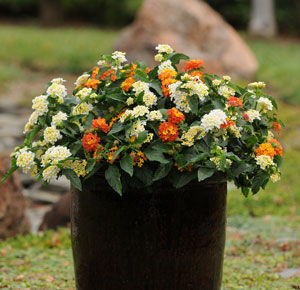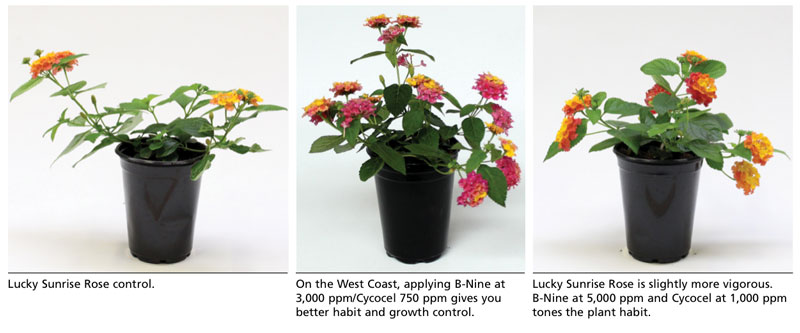1/1/2018
Regional Recommendations for Lucky Lantana
Kris Carlsson, Luís Muñoz & Ryan Kenny

Lantana production can be tricky: Get the timing or the growth regulation wrong and you have a plant out of flower or a tangled mess of pots.
The Lucky series from Ball FloraPlant has been an excellent solution as a medium-habit, early flowering lantana. And this class is playing a large role in two major trends with today’s homeowner: drought tolerance and pollinator friendly. Butterflies and bees LOVE lantana, and you can, too, with these helpful culture tips.
To keep Lucky Lantana a staple in your bench runs and pot-tight productions, we ran trials in California and Illinois. Our conclusions from both trials provide regional recommendations to match your greenhouse conditions.
California
To produce the beautiful 4-in. pots you see in the photos, we stuck our Lucky Lantana Week 3 with a pinch and transplanted Week 10. That’s aiming for a Week 17 finish—a 14-week crop time from stick to finish. Our California trial temperatures had an average daily temperature of 70F (21C). In February, we experienced about 8.9 mols per day in lighting. March saw 20.6 average daily mols, with April at 23 to 24 mols and above. (We get quite a bit of light in California!)
Our best practices for Lucky in our West Coast trials was to give a five-week liner time and pinch once. We used PGR with a tank mix of B-Nine at 3,000 ppm and Cycocel at 750 ppm two weeks after transplant. It’s also beneficial to apply a second application of the same tank mix approximately four to five weeks after transplant, if needed.
Illinois
With the same results in mind, but now in Illinois, we stuck cuttings Week 5, with a pinch Week 9 and transplanted Week 11. Our target finish was Week 19, which is an appropriate sales season for lantana in the Midwest and Northeast. Overall, though, it’s the same stick-to-finish crop time of 14 weeks, it’s just produced a little later in spring.
The average daily greenhouse temperature in our West Chicago trial was 71F (21.6C). The real difference was light levels: only 6.9 mols in March and 8.6 mols in April.
The best-practice we determined for the Midwest, Canada and the Northeast regions was a B-Nine spray at 2,500 ppm as a successful PGR for the prefinished stage, applied two weeks after transplant. Because of the low-light conditions, we used
B-Nine at 5,000 ppm and Cycocel at 1,000 ppm spray four weeks after transplant to tone the plant habit.
Thinking about the South and Southeast, a pinch is recommended along with a light B-Nine spray at 1,250 ppm to help tone liners. In our trials, if Lucky Lantana is produced outdoors at appropriate temperatures, no PGR is needed. Please consult our lantana finishing temperatures in our culture section at ballfloraplant.com to make sure your outdoor conditions are warm enough.
Full trial details are also available online, as well as in a greenhouse video from BFP TV. We hope these regional trials continue to help you produce the best-quality plants based on your climate and production needs. GT

Kris Carlsson is the Product Launch and Assortment Manager, and Luís Muñoz is Culture Research Technician for Ball FloraPlant. They are stationed at the company’s Arroyo Grande, California, facility. Ryan Kenny is Culture Trial Technician in charge of managing all culture trials for Ball FloraPlant in West Chicago, Illinois. For more culture guidelines, visit
ballfloraplant.com.